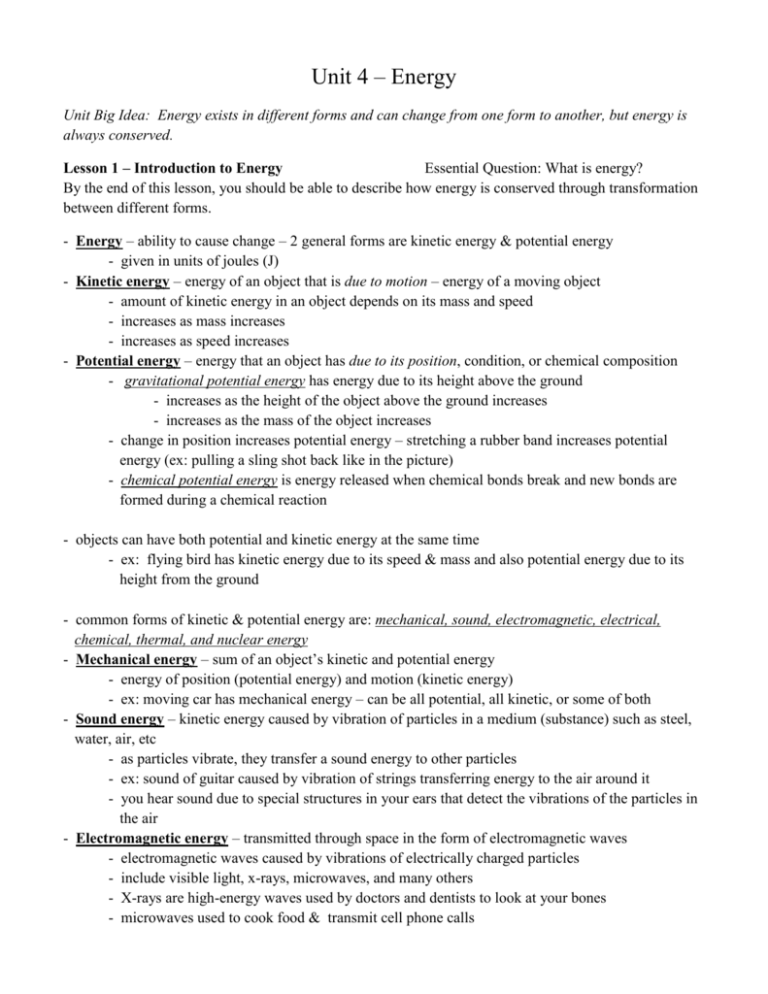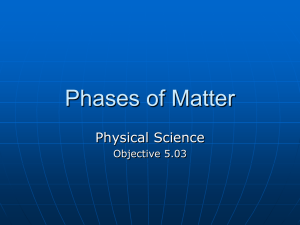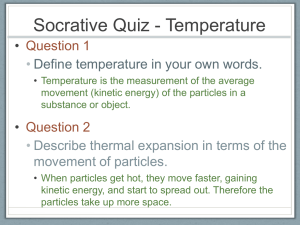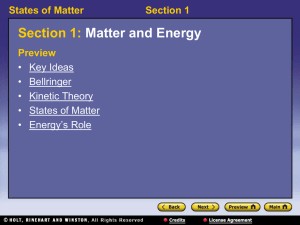Unit 4 – Energy Unit Big Idea: Energy exists in different forms and
advertisement

Unit 4 – Energy Unit Big Idea: Energy exists in different forms and can change from one form to another, but energy is always conserved. Lesson 1 – Introduction to Energy Essential Question: What is energy? By the end of this lesson, you should be able to describe how energy is conserved through transformation between different forms. - Energy – ability to cause change – 2 general forms are kinetic energy & potential energy - given in units of joules (J) - Kinetic energy – energy of an object that is due to motion – energy of a moving object - amount of kinetic energy in an object depends on its mass and speed - increases as mass increases - increases as speed increases - Potential energy – energy that an object has due to its position, condition, or chemical composition - gravitational potential energy has energy due to its height above the ground - increases as the height of the object above the ground increases - increases as the mass of the object increases - change in position increases potential energy – stretching a rubber band increases potential energy (ex: pulling a sling shot back like in the picture) - chemical potential energy is energy released when chemical bonds break and new bonds are formed during a chemical reaction - objects can have both potential and kinetic energy at the same time - ex: flying bird has kinetic energy due to its speed & mass and also potential energy due to its height from the ground - common forms of kinetic & potential energy are: mechanical, sound, electromagnetic, electrical, chemical, thermal, and nuclear energy - Mechanical energy – sum of an object’s kinetic and potential energy - energy of position (potential energy) and motion (kinetic energy) - ex: moving car has mechanical energy – can be all potential, all kinetic, or some of both - Sound energy – kinetic energy caused by vibration of particles in a medium (substance) such as steel, water, air, etc - as particles vibrate, they transfer a sound energy to other particles - ex: sound of guitar caused by vibration of strings transferring energy to the air around it - you hear sound due to special structures in your ears that detect the vibrations of the particles in the air - Electromagnetic energy – transmitted through space in the form of electromagnetic waves - electromagnetic waves caused by vibrations of electrically charged particles - include visible light, x-rays, microwaves, and many others - X-rays are high-energy waves used by doctors and dentists to look at your bones - microwaves used to cook food & transmit cell phone calls - sun releases large amounts of electromagnetic energy – some reaches Earth as radiant energy - Electrical energy – energy that results from the position or motion of charged particles - electrical energy that powers the lights in building & other places is caused by negatively charged particles moving through power line wires - the power line wires are positively charged particles that don’t move; these particles encourage the negatively charged particles to move across the wire & create an electric current - Chemical energy – form of potential energy - amount of chemical energy in a molecule depends on the kinds of atoms and their arrangement - during a chemical change, bonds between atoms break & new bonds form - sources of chemical energy include: foods you eat, batteries, & matches - heat – energy transfer from an object at a higher temperature to an object at a lower temperature - Nuclear energy – the source of nuclear energy is the nucleus of an atom - this type of energy is released when a nucleus of an atom breaks apart or joined together (nuclear fission & nuclear fusion) - ex: energy from the sun when it does nuclear fusion - The weather in space affects our ability to use energy on Earth - solar flares from the sun release millions of times more energy than anything on Earth. - cause problems when watching TV, talking on cell phones, using GPS maps to navigate, ground Planes from taking off, & interrupt airplane communications - Energy transformation – takes place when energy changes from one form into another - often one form of energy changes into more than one form - ex: rubbing your hands together is mechanical energy (energy of motion) – it transforms into a sound (sound energy) and heat (thermal energy) - ex: energy transformation takes place all the time in the body – chemical potential energy is stored in foods we eat is transformed into kinetic energy for movement of our bodies and thermal energy to keep your body warm - Law of conservation of energy – energy cannot be created or destroyed – it can only change forms - all the different types of energy in a closed system always add up to the same total amount of energy Lesson 2 Temperature Essential Question: How is temperature related to kinetic energy? By the end of this lesson, you should be able to relate the temperature of a substance to the kinetic energy of its particles. - Kinetic Theory of Matter – all of the particles that make up matter are constantly in motion - because the particles are always moving they have kinetic energy - the faster the particles move, the more kinetic energy they have - although the particle are constantly moving, they move in different directions & at different speeds in a random motion – this means each particle has a different amount of kinetic energy - the average kinetic energy of all these particles takes into account their different random movements - particles in a solid: not free to move around much & vibrate in place – held tightly together by forces of attraction - particles in a liquid: move around more freely than a solid & constantly sliding around & tumbling over each other as they move - particles in a gas: far apart from each other & move around at high speeds – particles collide with each other but otherwise don’t interact much - Temperature – measure of the average kinetic energy of all the particles in an object - particles in a cold liquid move more slowly than particles in a hot liquid - the warmer the temperature, the faster the particles move - in a hot piece of metal, like a heated up iron, the particles are vibrating in place at a very high speed – when the iron cools off to room temperature, the particles vibrate in place much more slowly - Absolute zero – temperature at which the motion of particles stop - it’s not possible to reach absolute zero with our current technology but we’ve gotten very close to it in laboratories - There are 3 common temperature scales, all of which measure the average kinetic energy of particles - To create a temperature scale – two known values and the number of units between them are needed – freezing point and boiling point of pure water often used as the two points - Degrees (°) – unit used to measure temperature in Celsius & Fahrenheit - Kelvin temperature scale doesn’t use the term “degrees” it just gives measurement in Kelvin - Thermometer – tool used to measure temperature – can be calibrated for Celsius, Kelvin, or Fahrenheit - Celsius Scale – temperature scale most commonly used around the world - developed in 1740s by Anders Celsius - pure water freezes at 0 °C and boils at 100 °C - Fahrenheit Scale – used most commonly in the United States - developed in early 1700s by Gabriel Fahrenheit - pure water freezes at 32 °F and boils at 212 °F - Kelvin Scale - used most commonly by physicists - developed in the 20th century when absolute zero was theorized - pure water freezes as 273 K and boils at 373 K - lowest temperature on the Kelvin scale is absolute zero or 0 K Temperature Conversions: To Convert Fahrenheit to Celsius: °C = 5/9(°F – 32) To Convert Celsius to Fahrenheit: °F = 9/5(°C) + 32 To Convert Celsius to Kelvin: K = °C + 273 Lesson 3 – Thermal Energy and Heat Essential Question: What is the relationship between heat and temperature? By the end of this lesson, you should be able to analyze the relationship between heat, temperature, and thermal energy. - Thermal energy – total kinetic energy of all particles in a substance - in metric system (SI), measured in joules (J) - substances at a higher temperature have a higher amount of thermal energy - Difference between thermal energy & temperature - temperature related to average kinetic energy of particles - thermal energy is total kinetic energy of all the particles - ex: a glass of water at the same temperature as a large lake has less thermal energy because there are less water particles in the glass than in the lake - ex: when ice is put into lemonade, energy is transferred from the warmer lemonade to the colder ice – lemonade’s thermal energy decreases & ice’s thermal energy increases causing the temperature of the lemonade to decrease - Heat – energy transferred from an object at a higher temperature to an object at a lower temperature. - when two objects at different temperatures come into contact with each other, energy is always transferred from the object with higher temperature to object with lower temperature - energy in the form of heat always flows from hot to cold - Calorie (cal) – measure of heat - one calorie is equal to the amount of energy needed to raise the temperature of 1 gram of water by 1 °C - one calorie is also equal to 4.18 joules - in nutrition, one Calorie (C) is equal to one kilocalorie or 1,000 calories - means one Calorie (C) contains enough energy to raise the temperature of 1 kg of water by 1 °C - each calorie in food contains 1,000 cal of energy - to find out how many Calories are in a piece of food, the food is burned inside an instrument called a calorimeter – a thermometer measures the increase in temperature, which is used to calculate how much energy is released – this is the number of Calories - The state of a substance depends on the speed of its particles. - adding energy in the form of heat can change the state of matter if the heat is enough to break the bonds between the particles. - removing energy in the form of heat can also change the state of a substance - Three main ways to transfer energy as heat: conduction, convection, & radiation - Conduction – transfer of energy as heat from one substance to another through direct contact - occurs when objects at different temperatures come into contact with each other - as the particles in these two objects collide together, some of the kinetic energy of the particles in the warmer object is transferred to the cooler object – as long as the objects are in contact, conduction continues until the temperatures are the same - - - - also occurs within single object when energy is transformed from warmer part of object to cooler part of the object Conductors – material that transfers heat very well - metals typically good conductors Insulators – material that is a poor conductor of heat - wood, paper, plastic foam (has many small spaces filled with air), oven mitt, flannel shirt - plastic foam cups will not easily transfer energy in the form of heat by conduction so they’re used to keep hot drinks hot - can still get hot over a long time but it takes more time than a conductor to get hot Convection – transfer of energy as heat by the movement of a liquid or gas - as temperatures increase, the density of the liquid or gas decreases, causing cooler / denser mass to sink and warmer / less dense mass to push upwards - when water boils in a pot, water molecules move roughly in circular patterns Convection current – motion of water as it heats up and cools down when being boiled, hot water rises then cools at the top, and sinks to the bottom where it heats up again - Radiation – transfer of energy by electromagnetic waves - include visible light, microwaves, infrared light, etc - sun is most significant source of radiation on Earth - all object, even humans, emit radiation and release energy - when radiation is emitted from one object and absorbed by another – heat is transferred - can transfer heat from warmer to cooler objects - unlike conduction & convection, radiation can travel through empty space (like when the sun’s energy travels through space to reach Earth) - Practical Uses of Radiation - solar cooker uses sun’s energy to cook food (don’t require fuel or release anything harmful) Lesson 4 – Effects of Energy Transfer Essential Question: How does the use of energy resources affect the environment? By the end of this lesson, you should be able to recognize how the production and use of different types of energy resources can have environmental consequences. - How people use energy - heat & cool homes, provide light, factories use to produce goods, produce & prepare food & drinks, vehicles to move - Sources of energy - sun is main source of energy for Earth - sun’s energy can be stored in plants through photosynthesis - chemical energy can be stored in minerals - Earth’s internal energy (geothermal energy) is used also - Energy source – an available source of stored energy that humans can use - Renewable resources – energy source that can be easily reproduced or replaced by nature - - - - - replaced at a rate equal to or greater than the rate that they are used - ex: solar energy, biomass energy, wind energy, geothermal energy, hydropower energy, trees, crops Nonrenewable resources – energy source that cannot be produced, grown, or restored as fast as it is used - ex: fossil fuel oil (petroleum), coal, natural gas, nuclear energy from energy-rich minerals like uranium Fossil fuel – energy resources made from carbon-rich plant and animal remains - heat & pressure from layers of sediment converted the remains to coal, petroleum, & natural gas - nonrenewable because they take millions of years to form - burning them releases carbon dioxide gas into the atmosphere – a greenhouse gas that heats up the atmosphere and creates acid rain & other forms of pollution - more than ¾ energy in US comes from fossil fuels Coal – sedimentary rock formed from remains of dead plants at bottom of ancient swamps - landscape is destroyed & water is polluted when coal is removed from the ground Natural gas – gases that become trapped in rock formations - methane (CH4) is main component of natural gas - burn more cleanly than other fossil fuels but still produce carbon dioxide gas Petroleum - means “rock oil” – formed from remains of single-celled aquatic organisms that lived long ago - mined on land or under ocean - separated into fuels like gasoline, diesel, and jet fuel - many times is transported by a pipeline, truck, or ship that can leak and pollute the environment - pollutants from burning petroleum can react with sunlight to make smog - Alternative sources of energy are mainly from renewable resources - Solar energy – renewable energy from the sun converted into electrical energy - solar panels absorb energy from sun and can create steam to run a generator to make electrical energy - free & clean but technologies to transform solar to electrical aren’t widely used - sunlight doesn’t fall evenly all over Earth - Nuclear energy – converts nuclear energy (made from fission) into electrical energy - splits nucleus of uranium atom to release thousands times more energy than burning same amount of coal - nonrenewable because minerals in Earth’s crust cannot be replaced - nuclear power plants don’t produce carbon dioxide gas (greenhouse gas) but do produce harmful radioactive wastes that must be safely stored - Hydroelectric energy – energy from water is one of most widely used alternative energy source - water in fast-moving rivers or flowing downhill through dams turns generators that generate electrical energy - powered by water cycle & is renewable - can only be produced by large volumes of falling water – can flood lands to produce reservoirs and destroy lands – dams can also disrupt migratory paths of fish & create erosion problems - Wind energy – blowing wind causes blades of wind turbines to turn creating electrical energy - renewable & doesn’t cause pollution - requires steady, strong winds that are found only in certain places - wind farms can create noise pollution & threaten birds & bats that fly too close to turbine blades - Geothermal energy – extracted from heat stored within Earth - available near hot springs, geysers, or active volcanoes - water or steam heated by geothermal energy can be used to heat buildings directly or to generate electrical energy - renewable but found only in specific areas on Earth - Energy from burning Biomass – biomass includes living and recently dead organic materials that can be used as fuel - ex: trees, crops, decaying organic matter (peat) - some types directly burned for fuel (burn wood to heat home) - some (like corn) are converted into fuels such as methane or alcohol and then burned - renewable but releases carbon dioxide into air to further pollute it - Acid Rain – created by burning fossil fuels which produces gasses like sulfur dioxide & nitrogen oxides – when these gases mix with water in the air they fall to Earth as rain - harmful effects on plants, aquatic animals, human-made objects such as building & statues - falls into rivers & lakes changing the acidity of water which can deform animals or kill them - reacts with metals and with substances in marble and stone to weaken and wear away the material








